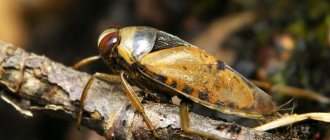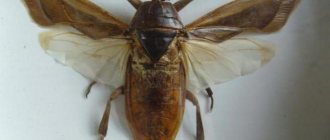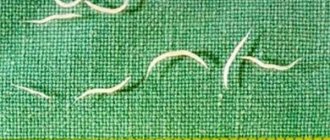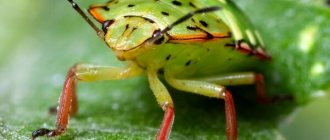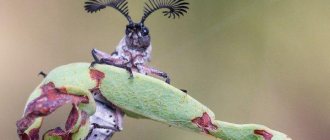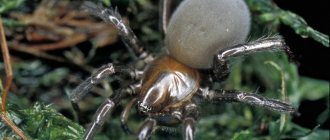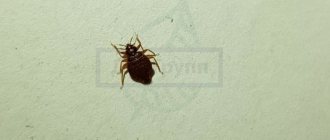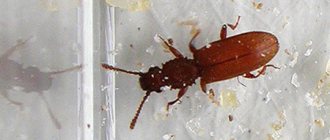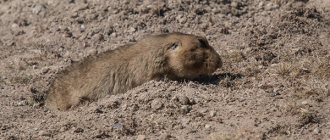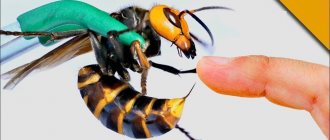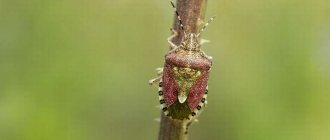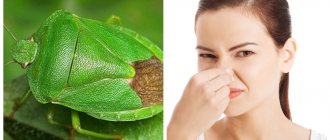The Belostoma bug is the largest representative of the order Hemiptera, reaching a length of up to 17 cm. The giant water bug lives in East and Southeast Asia, as well as in some regions of North and South America.
Giant water bug photo
The insect's body is flat, elongated and oval in shape, reminiscent of a fallen leaf. The color may vary depending on the bottom of the reservoir (this is necessary for camouflage), but most often it is brown. The eyes are large and reticulated. The wings are membranous and transparent. There are hooks on the front legs, the main purpose of which is to capture the future victim.
Belostomas can feed on small turtles photo
The insects live in shallow, algae-covered, warm waters and, when in large numbers, are capable of causing significant damage to fisheries by eating young fish, which is why they have received the nickname “fish killers.” The diet also includes frogs, amphibians, worms and small turtles.
Is it dangerous for humans?
This insect does not pose an immediate danger to humans. These aquatic arthropods do not consider humans as prey due to their huge size difference.
Aquatic predators choose small prey that live next to them.
At the same time, these insects are not absolutely safe for people. Under certain circumstances they bite, but they do this extremely rarely. Curious children who stick their hands everywhere often suffer from them.
If they catch such a predator, they risk receiving a sting reminiscent of a bee. Although the poison that saliva contains is not dangerous to humans, the bite site can be felt for a long time.
Recommendations
- Weaving, Alan; Picker, Mike; Griffiths, Charles Llewellyn (2003). A Field Guide to the Insects of South Africa
. New Holland Publishers, Ltd. ISBN 1-86872-713-0. - Sahayaraj, Kiterin; Kanna, Ayahami Vinoth; Kumar, Subramanian Muthu (2010). "General morphology of the nutrient canal, salivary apparatus and digestive enzymes of the salivary gland of Catamirus brevipennis
(Servile) (Hemiptera: Reduviidae)."
Journal of the Society for Entomological Research
.
12
(2): 37–50. Retrieved December 14, 2012. - Bulber, Matthew W.; Herberstein, Maria Elizabeth; Gerasimos, Kassis (March 2014). “The assassin beetle requires the dangerous prey ant to bite first.” Current Biology
.
24
(6): R220 – R221. doi:10.1016/j.cub.2014.02.006. PMID 24650903. - Kizerin, Sahayaraj; Muthukumar, S. (2011). "Zootoxic effects of the poisonous saliva of the reduviid Rhynocoris marginatus (Fab.) (Hemiptera: Reduviidae) on Spodoptera litura (Fab.)". Toxicon
.
58
(5): 415–425. doi:10.1016/j.toxicon.2011.06.001. PMID 21787800. - https://www.paho.org/hq/index.php?option=com_topics&view=article&id=10&Itemid=40743&lang=en
- Weyrauch, Christiane; Munro, James B. (October 2009). "Molecular phylogeny of assassin bugs (Hemiptera: Reduviidae) based on mitochondrial and nuclear ribosomal genes." Molecular phylogenetics and evolution
.
Elsevier. 53
(1):287–299. Doi:10.1016/j.ympev.2009.05.039. PMID 19531379. - Wang, Bo; Xia, Fangyuan; Engel, Michael S.; Perrichot, Vincent; Shea, Gongl; Zhang, Haichun; Chen, Jun; Jarzembowski, Edmund A.; Wappler, Thorsten; Rust, Jess (June 2016). "Camouflage carrying litter among diverse lineages of chalk insects." Science achievements
.
2
(6): e1501918. doi:10.1126/sciadv.1501918. ISSN 2375-2548. PMC 4928993. PMID 27386568. - Poinar, George (January 2019). “Primitive triatomine bug, Paleotriatoma metaxytaxa gen. Etsp. Nov. (Hemiptera: Reduviidae: Triatominae), in Middle Cretaceous amber from northern Myanmar." Cretaceous Studies
.
93
: 90–97. Doi:10.1016/j.cretres.2018.09.004.
Types of water bugs
Aquatic insects are divided into 4 families:
- Water strider. They differ from other relatives in the way they move and hunt. They do not live under water, but spend their entire lives gliding along its surface.
- Gladysh. Large insects sliding through the water with their belly up. They are capable of flying over long distances, so they are found in various places. It is often called the water wasp.
- Greblyak. Outwardly, this species is practically no different from the smoothies, but the smoothies swim with their backs up. They spend most of their lives in areas with stagnant waters.
- Belostoma. A giant-sized water bug that lives primarily in the tropics. Belostoma is a nocturnal insect. During the hunt, it sits in ambush, and when a victim appears, it infects it with paralyzing poison.
Insects from these families primarily inhabit fresh water bodies, but some species are also comfortable in salty sea water.
Video
Water bug: types and dangers
Predator or not?
The water mite is a predator . Even small fish and frogs can be their prey, but in most cases, bedbugs eat fish fry, tadpoles, larvae and mosquitoes.
Smooth fish differ from many other species in their unusual swimming technique. After the bug has immersed itself in the water, it begins to turn over with its belly up. Thus, the insect keeps the surface of the reservoir under control and hunts. Smoothies live in stagnant water or in bodies of water with slow currents. The water bug can also be found in large puddles and large containers of water.
The insect lies in wait for its prey on stones or plants, and when it approaches the bug very close, it grabs it with its front paws and pulls it to its mouth. All aquatic insects feed almost the same . They insert their proboscis into the body of their prey and inject it with special substances that promote internal decomposition of organs. After this, the insects suck out the resulting liquid.
Features of behavior
What does a water bug look like:
- Water strider. Representatives of the family have a thin, highly elongated body with 3 pairs of legs. The rear ones provide movement along the surface of the liquid. Water striders have low weight and a large support area, so they do not break through the water film and do not dive. They easily glide along the surface of the water, pushing off from it with their limbs. The front pair of paws is designed to hold food.
- Smooth bug. The size of the insect does not exceed 15 mm. The smoothie has a flat belly, which is darker than the wings. Visually the body resembles a boat. When immersed on the surface of the water, the smoothie turns over on its back and begins to vigorously rotate its hind paws-oars. It has large eyes that closely watch its victims on the surface of the water.
- Common comb. There are about 600 subspecies of this insect. From a distance, it can easily be confused with a smooth fish due to its swimming method. A distinctive feature of rowers is the unique structure of each pair of limbs. The first pair of legs is short, equipped with tarsi with one segment. They resemble spatulas dotted with small teeth (a musical instrument called the paddle). Sitting under water and holding onto the plant with its middle paws, the predator runs its forelimbs along the surface of the proboscis, creating chirping sounds.
- Giant water bug. Belastoma can grow up to 10-15 cm in length. Their hind legs are designed for swimming, not walking. The forelimbs are strong, large, but short. At the ends there are hooks resembling claws. They help to capture and hold the prey. Belastomas do not breathe underwater, so they are often forced to surface for a portion of air. Uses wings only when necessary.
Most orders of these insects, except water striders, are adapted for life under water. Gladyshki and paddlefish make sounds reminiscent of the chirping of grasshoppers.
When they see danger, they pretend to be dead, and if this does not help, they release an odorous substance with an unpleasant odor. Enemies evaluate such actions as a warning of the presence of poison.
Due to their special swimming style, smoothies are not noticed by predatory fish in the water. The smooth body of the insect is colored to match the pond, so it is difficult to notice from the depths. Spreading its limbs to the sides, the smooth fish moves smoothly, using its fins to push off.
Birds ignore them because from a flying height they can easily be confused with a plant.
On the other hand, this manner of movement and camouflage helps smoothies get closer to the prey living in the upper layer of water and begin eating. But such insects cannot stay in the water all the time.
From time to time they descend to the abdomen and rise to the surface for a portion of air. Often at this time they themselves become victims.
Taxonomy
Reduviids are included in the suborder Heteroptera of the order Hemiptera. Almost all members of the family are carnivorous, with the exception of a few blood-sucking species, some of which are important vectors of disease. About 7,000 species from more than 20 recognized subfamilies have been described, making it one of the largest families of Hemiptera.
Name Reduviidae
comes from the type genus,
Redevius
.
This name, in turn, comes from the Latin reduvia
, meaning "burr" or "remnant". The name may have been inspired by the lateral projections on the abdomen of many species.
Common genera include:
- Lopodites
- Melanolestes
- Platimeris
- Pselliope
- Psytalla
- Rasakhus
- Redevius
- Riginia
- Sinea
- Zelus
Although members of most subfamilies do not have common names other than assassin beetles
, among the many subfamilies there are several with their own common names that are quite widely known, for example:
- Ambush bugs
- subfamily Phymatinae - Thread-legged bugs
- subfamily Emesinae, including the genus
Emesai - Kissing bugs
(or pineal bugs) are a subfamily of Triatominae, unusual in that most species are bloodsuckers and some are important vectors of disease. - species known as the "Wheel Bug" - Arilus cristatus
Habitat
The smooth water bug can live not only in ponds. Puddles or barrels of water also become their habitat. And in the evening they are found on verandas or terraces. Greblyaki live in temperate and northern latitudes.
They are active both in summer and winter. Sometimes they are caught under the ice. Water bugs are often attracted to light at night and will head towards it.
The large aquatic predator prefers shallow reservoirs with warm water. India and Thailand are their main habitats. They are also found on the American continent. A favorable environment for their habitat is observed in the state of Florida.
further reading
- D. R. Lauck (1962). "Monograph of the genus Belostoma
(Hemiptera), Part I. Introduction and
B. Dentatum
and
Subspinosum
group."
Bulletin of the Chicago Academy of Sciences
.
11
(3): 34–81. - D. R. Lauck (1963). “Monograph of the genus Belostoma
(Hemiptera), part II.
B. aurivillanum
,
Testaceopallidium
,
Dilatatum
, and
Discretum
group."
Bulletin of the Chicago Academy of Sciences
.
11
(4): 82–101. - D. R. Lauck (1964). "Monograph of the genus Belostoma
(Hemiptera, part III.
B. Triangulum
,
Bergi
,
Minor
,
Bifoveolatum
, and
Flumineum
group."
Bulletin of the Chicago Academy of Sciences
.
11
(5): 102–154. - Menke A.S. (1960). "Taxonomic study of the genus Abedus
Table (Hemiptera, Belostomatidae)."
University of California Entomology Publications
.
16
(8): 393–440. - R. L. Smith (1974). "Life History of Abedus Herberti
in Central Arizona" (PDF).
Psyche
.
81
(2):272–283. Doi:10.1155/1974/83959.
Insect nutrition
Small species prey on representatives of the fauna that are not larger than them. They lead a fairly active lifestyle. Large water bugs await their prey in a shelter.
The piercing-suction mouthparts of bedbugs do not allow them to eat solid food or swallow prey whole.
The diet of such insects is varied. It depends on the size of the potential prey. Most individuals use nerve poison. After it is sprayed, the victim slows down his movements or is completely paralyzed.
The predator grabs the prey with its paws, pierces its body with its proboscis and sucks all the nutritional material.
The diet consists of small insects, their larvae, fish eggs or amphibians. Paddlers prefer algae or mosquito larvae. Bedbugs are predators, so fighting for prey is no stranger to them. And if the diet is too meager, then they calmly eat their relatives.
What kind of animal?
Recently I came across a newspaper of scanwords, and there was a question: a water bug with five letters, I’ve already tried all the names and the paddlefish remembered and nothing suits the white-tailed and smooth-footed, I think what kind of animal is this, I mean, a bug with five letters, and then it dawned on me, yes, this is a float.
It lives mainly in bodies of water with dense vegetation, on which it constantly crawls; for this reason the British call it the “water creeper”. In principle, it is also safe for humans if, of course, you do not touch it; the active predator hunts not only young fish and insects, but also mollusks. Here’s an interesting five-letter water bug, so if you come across such a question, then you you know the answer: water bug 5 letters - this is plaut.
Chalk for cockroaches and bedbugs "Mashenka"
Offspring
Aquatic arthropods reproduce by eggs. But their method of laying differs markedly. The female smoothie chooses the thickness of plant stems to lay eggs.
Paddlefish catch eggs with their offspring under deep algae or on other objects located under water.
Belostoma keeps future offspring under supervision all the time. The female lays eggs on the back of the male. There are usually so many eggs that its entire surface is filled.
A water bug with eggs on its back makes all movements (walks or swims). Before the appearance of the larvae, the future father is completely focused on caring for the offspring.
The male selects the required temperature regime for the eggs and offspring. Protects them from other predators, and also ensures that there is always good air circulation around the masonry.
The male belostomy practically does not eat food during this period, therefore, after the birth of the larvae, it often dies.
During their life cycle, water bugs go through 3 main stages: egg, larva, and adult. The hatched larvae visually closely resemble adult individuals, but are significantly smaller in size.
Before the larvae transform into a full-fledged individual, several molts occur.
Lifestyle
For most of their lives, bedbugs are underwater, breathing atmospheric air, which is why the insect needs to periodically rise to the surface. The respiratory organs consist of two breathing tubes located at the rear end of the abdomen, so in order to inhale, the bug sticks the back of its body out of the water. Bed bugs swim poorly, so they hunt in shallow water from ambush. As soon as the prey is within reach, the bug throws out its forelimbs, firmly digging into the victim, after which it makes a puncture with its piercing-sucking proboscis and introduces an enzyme that dissolves tissue, and then sucks out the resulting liquid mass.
In case of danger, belostomas freeze and pretend to be dead, and sometimes release an odorous secretion from the anal glands located in the back of the abdomen
The role of smoothies in nature
The smooth water bug controls the number of mosquitoes. One individual eats up to 100 of their larvae per day. When aquatic arthropods eat fish fry, this is a normal part of the food chain.
This is considered as pest only in fish farms.
On the other hand, smoothies are food for other representatives of the animal world. Water bugs are an important link in the ecosystem of individual stagnant bodies of water, as well as the general world fauna.
Reproduction
The period of mating and egg laying occurs in the spring. One oviposition contains up to 100 eggs, laid at different times. One female lays up to 4 eggs at a time, so the bugs mate several times until the required number of eggs is laid.
Belostomas are classified as insects with an incomplete type of transformation. That is, throughout their life they go through only two stages of development: the larva and the imago (adult insect). The beginning of the larval stage is considered to be the exit from the egg. Newborn larvae lack normal coloring and their body coverings are soft. The larvae's integument gradually hardens and becomes colored, after which they enter a phase of increased feeding. The stage of increased growth is accompanied by several molts, when the larva sheds the chitinous cover that has become cramped for it. This is how the body enlarges and transforms into an adult form.
Victim of the belostoma bug
The harm and benefits of giant water bugs
When exposed to the persistent hands of curious humans, giant waterbugs defend themselves with stings, much like a bee or wasp. This is not fraught with any serious consequences. The bitten area calms down on its own after 7 days.
And the main benefit of belastoma is eating three-keeled turtles, which pose a danger to the brood of commercial fish.
These harmless giant water bugs are also actively used as food. In Thailand they are served fried in many restaurants. The demand among tourists for such exotic dishes is quite high.
Every year the lakes become poorer in such aquatic inhabitants. But they are also trying to breed them on special farms.
The water bug is a special type of arthropod. For humans they are practically harmless, but for fauna they are important. Destroying these living beings recklessly or for fun is prohibited. A person must take care of the environment, including such insects.
Gastronomic delicacy
In Vietnam, giant bugs are a very valuable resource. There, liquid is collected from the males from the pheromone-producing sacs. Ca'Cuong is the name of the product that has already entered the world market. One drop of this substrate changes the taste of the dish and, according to the Vietnamese, has a very beneficial effect on... you know what.
In Thailand, these insects are simply fried - this is a common dish for local residents. It is called Malaeng da Na, it is sold in all markets and is inexpensive. There is probably not a tourist who has not tried fried giant bugs.
But in the Philippines, the legs of these insects are removed and they are made... canapés for liqueurs. They are also fried whole or chopped with garlic, tomatoes, onions - basically, whatever you like. And they eat with pleasure.
